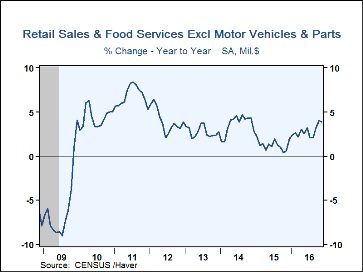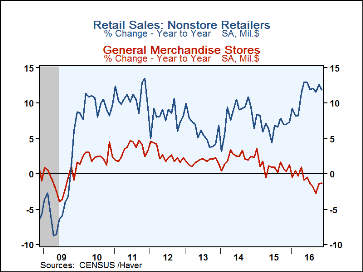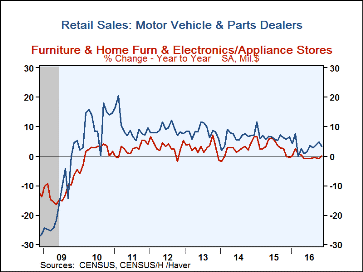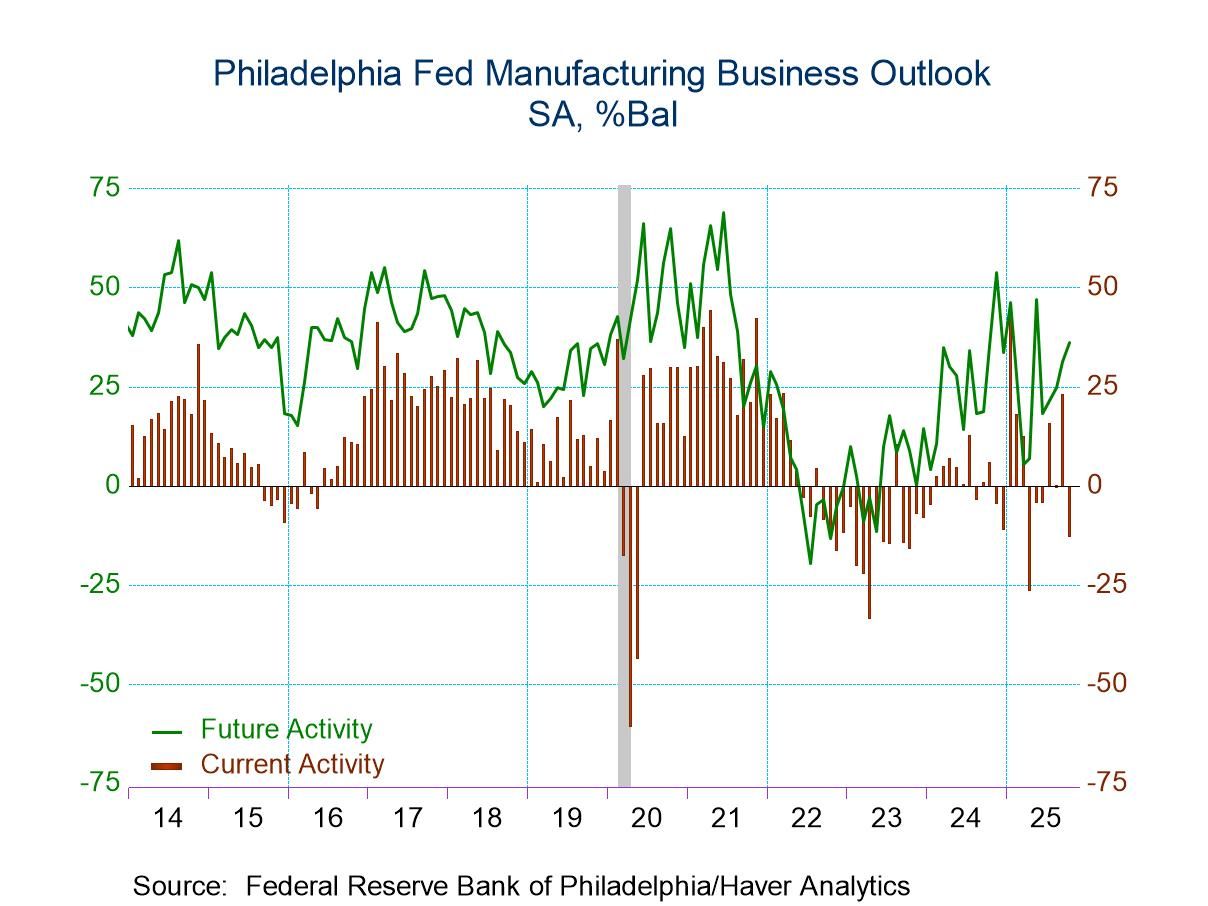 Global| Dec 14 2016
Global| Dec 14 2016U.S. Retail Sales Increase Minimally
by:Tom Moeller
|in:Economy in Brief
Summary
Consumers grew cautious ahead of the holiday spending season. Total retail sales & spending at restaurants nudged 0.1% higher (3.8% y/y) during November following a 0.6% October rise, revised from 0.8%. A 0.4% increase had been [...]
Consumers grew cautious ahead of the holiday spending season. Total retail sales & spending at restaurants nudged 0.1% higher (3.8% y/y) during November following a 0.6% October rise, revised from 0.8%. A 0.4% increase had been expected in the Action Economics Forecast Survey. Three-month sales growth eased to 1.2%, its slowest pace since May.
A 0.5% decline (+3.3% y/y) in purchases of motor vehicles & parts held back last month's overall spending increase. The decline roughly matched a 0.8% drop in unit sales of light vehicles. Excluding autos, overall retail sales improved 0.2% (3.9% y/y) after a 0.6% gain. That was the weakest rise in three months. A 0.5% increase had been expected.
Retail sales eased slightly last month (+3.6% y/y) after a 0.7% rise. Discretionary spending growth slowed markedly. Purchases at nonstore retailers improved a minimal 0.1% (11.9% y/y) following a strong 1.4% increase. Also weakening were sales at sporting goods, hobby, book & music stores which fell 1.0% (-1.4% y/y) following a 0.7% rise. Building materials & garden equipment store sales increased 0.3% (4.3% y/y) for a second straight month. Gasoline service station sales also improved 0.3% (4.0% y/y) following two months of strong gains with higher prices. To the upside were restaurant sales. Sales at food service & drinking places rose 0.8% (4.9% y/y), a rebound after a 0.3% decline.
Sales in the retail control group, which measures nonauto sales less gasoline & building materials, inched 0.1% higher (3.4% y/y), the weakest gain in three months. Three-month growth improved, however, to 4.1%, the strongest rise since Q2. Sales of furniture & home furnishings gained 0.7% (4.1% y/y) after a 0.5 decline, while sales at electronics & appliance stores ticked 0.1% higher (-3.8% y/y) following five consecutive monthly declines. Clothing & accessory store sales remained unchanged (0.9% y/y) after a 0.1% uptick. Sales of general merchandise stores gained 0.1% (-1.3% y/y) after six consecutive monthly declines.
In the non-discretionary spending categories, food & beverage store sales increased 0.4% (3.1% y/y) following a 0.7% increase. Purchases at health & personal care stores ticked 0.1% higher (6.2% y/y) following no change.
The retail sales data can be found in Haver's USECON database.
| Retail Spending (%) | Nov | Oct | Sep | Nov Y/Y | 2015 | 2014 | 2013 |
|---|---|---|---|---|---|---|---|
| Total Retail Sales & Food Services | 0.1 | 0.6 | 1.0 | 3.8 | 2.3 | 4.1 | 3.8 |
| Excluding Autos | 0.2 | 0.6 | 0.8 | 3.9 | 1.3 | 3.6 | 2.7 |
| Non-Auto Less Gasoline, Building Supplies & Food Services (Control Group) | 0.1 | 0.6 | 0.3 | 3.4 | 3.3 | 4.0 | 2.9 |
| Retail Sales | -0.0 | 0.7 | 1.0 | 3.6 | 1.6 | 3.9 | 3.8 |
| Motor Vehicle & Parts | -0.5 | 0.5 | 1.9 | 3.3 | 6.6 | 6.4 | 8.3 |
| Retail Less Autos | 0.1 | 0.8 | 0.8 | 3.7 | 0.2 | 3.2 | 2.6 |
| Gasoline Stations | 0.3 | 2.5 | 3.6 | 4.0 | -19.4 | -2.4 | -1.2 |
| Food Service & Drinking Places Sales | 0.8 | -0.3 | 0.7 | 4.9 | 8.1 | 6.1 | 3.7 |
Tom Moeller
AuthorMore in Author Profile »Prior to joining Haver Analytics in 2000, Mr. Moeller worked as the Economist at Chancellor Capital Management from 1985 to 1999. There, he developed comprehensive economic forecasts and interpreted economic data for equity and fixed income portfolio managers. Also at Chancellor, Mr. Moeller worked as an equity analyst and was responsible for researching and rating companies in the economically sensitive automobile and housing industries for investment in Chancellor’s equity portfolio. Prior to joining Chancellor, Mr. Moeller was an Economist at Citibank from 1979 to 1984. He also analyzed pricing behavior in the metals industry for the Council on Wage and Price Stability in Washington, D.C. In 1999, Mr. Moeller received the award for most accurate forecast from the Forecasters' Club of New York. From 1990 to 1992 he was President of the New York Association for Business Economists. Mr. Moeller earned an M.B.A. in Finance from Fordham University, where he graduated in 1987. He holds a Bachelor of Arts in Economics from George Washington University.










